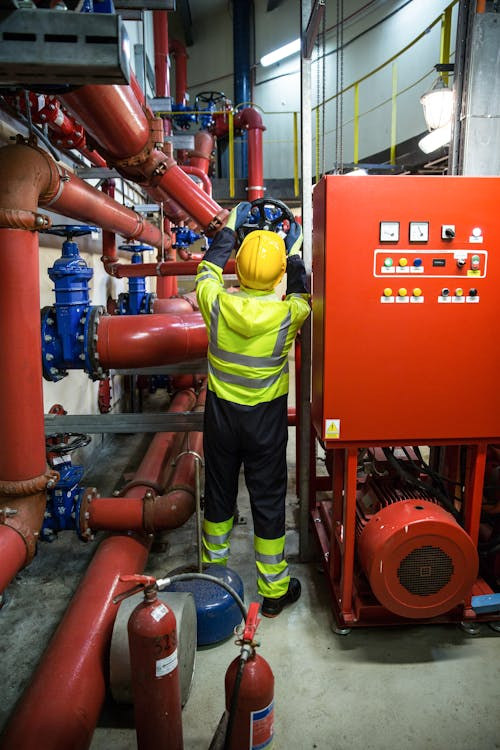
Winter Readiness Guide for Wet and Dry Fire Sprinkler Systems
Winter brings unique challenges for commercial fire sprinkler systems, and failing to prepare can put your business, employees, and property at risk. Freezing temperatures can cause wet sprinkler system pipes to burst and dry sprinkler systems to malfunction, leaving your fire protection compromised.
Proper winterization is essential to ensure your fire sprinklers remain operational when you need them most.
According to the National Fire Protection Association (NFPA) (1), commercial buildings with fire sprinkler systems experience a significant reduction in fire-related deaths and property damage.
However, to maintain this level of protection, businesses must take proactive steps to prepare their fire sprinkler systems for winter.
Understanding the Differences Between Wet and Dry Fire Sprinkler Systems
While there are multiple types of fire sprinkler systems, commercial buildings utilize two primary types of fire sprinkler systems: wet pipe and dry pipe systems. Each system functions differently and requires unique winterization strategies.
Wet pipe fire sprinkler systems
Wet pipe systems are the most common type of fire sprinkler system.
They contain water in the pipes at all times, ready to discharge immediately when a fire is detected. However, this constant water presence makes them vulnerable to freezing temperatures. If pipes freeze and burst, it can lead to costly repairs, water damage, and compromised fire protection.
Dry pipe fire sprinkler systems
Dry pipe systems are commonly used in areas where freezing is a concern, such as unheated warehouses, parking garages, and outdoor facilities. Instead of water, dry pipe systems hold pressurized air or nitrogen until a fire triggers the system, releasing water into the pipes.
While these systems are less susceptible to freezing, they still require proper maintenance to prevent condensation buildup, corrosion, and system failures.
Winterization Tips for Wet and Dry Fire Sprinkler Systems
1. Insulate and heat vulnerable areas
For wet pipe systems, keeping pipes in heated areas is the best way to prevent freezing. Insulate pipes in unheated spaces and use heat tracing to maintain a safe temperature. Be sure attics, basements, and crawl spaces with sprinkler piping have adequate heating.
2. Drain low points in dry pipe systems
Dry pipe systems rely on pressurized air, but condensation can still accumulate inside the pipes. Regularly draining the system’s low points prevents water from collecting and freezing inside the pipes, which can lead to blockages or pipe damage.
3. Conduct routine inspections and maintenance
Regular inspections help identify potential issues before they turn into costly failures. Ensure that all system components, including control valves, pressure gauges, and alarm systems, are functioning correctly.
Work with certified fire protection professionals to schedule routine maintenance and winterization services.
4. Test and maintain the air compressor in dry systems
Dry pipe systems use air compressors to maintain pressure inside the pipes. If the compressor fails, water can enter the pipes prematurely, increasing the risk of freezing. Ensure that the air compressor is in good working order before the coldest months arrive.
5. Keep sprinkler control valves accessible
Fire sprinkler systems rely on properly functioning control valves. Make sure they remain accessible and free from obstructions, such as snow or ice buildup. In the event of an emergency, first responders and facility managers must be able to quickly access the system’s control valves.
6. Prepare for power outages
Winter storms can cause unexpected power outages. If your building relies on electrically powered heating systems to keep pipes warm, have a backup power source available to prevent freezing. Additionally, ensure that fire alarm and monitoring systems remain operational during power disruptions.
Partner With Kistler O’Brien Fire Protection for Winter Readiness
Ensuring your fire sprinkler system is properly winterized requires expert knowledge and professional maintenance. Kistler O’Brien Fire Protection offers comprehensive fire protection solutions, from system design and installation to inspections, maintenance, and emergency repairs.
With a team of certified engineers, project managers, and life safety professionals, Kistler O’Brien Fire Protection provides turnkey fire protection solutions tailored to your business. Whether you operate a small office or a large industrial facility, our customized approach ensures that your commercial fire sprinkler system is ready to perform when it matters most.
Why Choose Kistler O’Brien Fire Protection?
- Expert knowledge in compliance and safety: Our professionals ensure your system meets NFPA codes (2) and local fire safety regulations.
- Preventative maintenance plans: Regular inspections and maintenance services help businesses avoid costly repairs and emergency failures.
- Dedicated support for every industry: We work with general contractors, architects, electrical and code officials, and businesses of all sizes.
Learn More About Commercial Fire Sprinkler Systems
Don’t wait until freezing temperatures put your fire sprinkler system at risk.
Our team will assess your system, identify potential vulnerabilities, and provide a customized winterization plan to keep your business protected.
Ready to secure your fire protection system for winter? Contact Kistler O’Brien Fire Protection today!
Sources:

